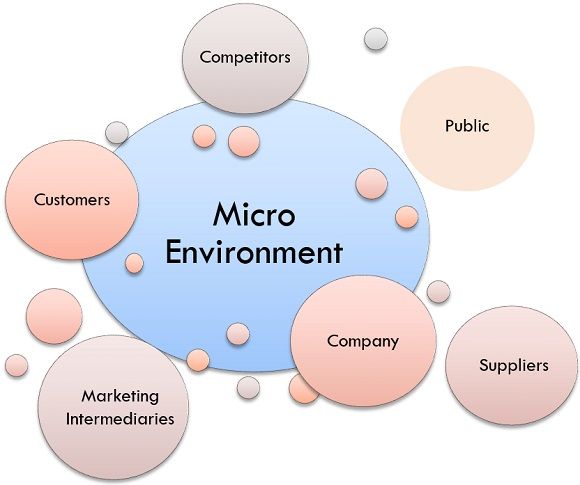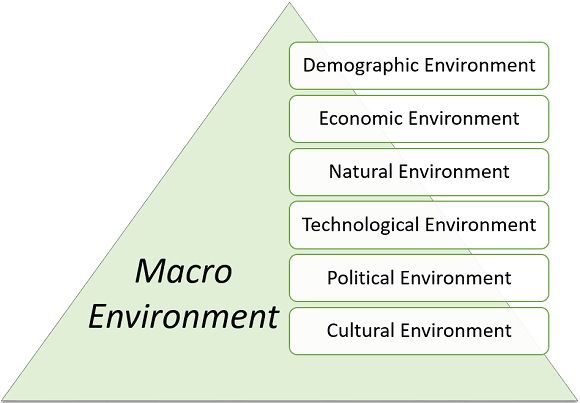Definition: Marketing environment implies the atmosphere of the market which consists of the internal environment, micro-environment and macro-environment. It manages the various forces and factors of the organization that influences their marketing management skills to develop and retain favourable transactions with its recognized customers.
Content: Marketing Environment
Factors of Marketing Environment
Following are the factors of the marketing environment:
1. Internal Environment
While developing plans marketing manager of an organization takes various bodies into account, i.e. Top management, research and development, finance, manufacturing, sales promotion, purchasing, advertisement departments etc. Environmental energies are dynamic, and any variation in them brings, threats and opportunities, uncertainties for the marketers. Variations in the environmental energies can be tracked through environmental scanning, i.e. examination of secondary sources like trade and government, business and environmental analysis, i.e. understanding of the information assembled through environmental scanning.
Marketers try to forecast what can happen in the future with the use of tools like marketing information or marketing research and marketing intelligence system and endure to alter their marketing efforts and frame future marketing strategies. The organization must think about the customer’s value and satisfaction.
2. Micro Environment
The micro-environment of the organization is made up of distinct energies in its recent environment that involves its ability to operate productivity in its preferred markets. It includes:
- Company: While outlying marketing plans, marketing management selects other companies on a charge like research and development, finance, manufacturing, purchasing, accounting, etc. A marketing manager should also work persistently with other company areas.
- Suppliers: They furnish the resources required by the organization to produce its goods and services. Suppliers are the essential links in the organization’s overall consumer “value delivery system”. Supplier developments can intensely influence marketing. The marketing manager should watch the availability of the supply, delays, supply shortages, strikes which can increase the sales cost temporary and smash customer’s satisfaction permanently.
He also keeps an eye on the price trends of their key inputs. Increasing supply cost may demand an increase in the prices that can ruin the organization’s sales volume.
- Marketing Intermediaries: These are the firms that benefit the organization to advertise, sell and distribute goods to the absolute buyers. They involve physical distribution firms, middlemen, financial intermediaries, marketing services agencies. Wholesalers and retailers are the middlemen who support the enterprise to search for customers and make sales to them.
- Customers: The organization must scrutinize its consumer’s market. Consumer’s market includes
- Household and individuals: purchases goods and services for personal use.
- Business markets: Acquire goods and services for additional transformation or for applying in their production process.
- Resellers market: Procure services and goods for reselling it at a profit.
- Institutional markets: It includes hospitals, schools, prisons, nursing homes, and other institutions which supplies goods and services to people in their responsibility.
- Government markets: It comprises of government agencies that purchase goods and services for individuals who are in need. Every market type has certain features that ask for careful study by the sellers. At any time, the enterprise may carry out one or more consumer markets.
- Competitors: The marketing theory affirms that to be fortunate, an organization must fulfill the needs and wants of the customer’s superior to its competitors do. Thus, marketers should do more rather than merely adopting the need for target customers. No single marketing approach is advantageous for all organizations. Every organization should consider its industry position and size correlated to those of its competitors.
- Public: Public may hold attention in the business undertakings, and it’s the duty of the organization to please the people at large in addition to competitors and customers. A public is described as any society that has a definite and hidden interest in or impacts on an organization’s capability to accomplish its objectives. Public relations are surely a vast marketing operation which must be completely taken care of by the company.
Favourable reactions, goodwill, donations, and promising future buyers are some of the returns which an organization anticipates from the public. There are seven types of the public; they are as follows:
-
- Media public: It includes TV, magazines, newspaper, radio, etc.
- Financial public: It includes Investment houses, banks and shareholders.
- Local public: It includes community groups, surrounding residents.
- Government public: It includes government developments.
- Citizen public: It includes minority groups, environmental groups, consumer organizations.
- Internal public: It includes managers, workers, the board of directors.
- General public: It includes public attitude and public opinions.
The macro-environment is made up of immense forces that not only influence the organization and the industry, although other factors in the macro-environment. The elements of the macro-environment are:

- Demographic Environment: Society is the first environmental factor of interest to marketers as the people in society create the market. Marketers are closely interested in the size of the society, its density, and geographical distribution, age distribution, mobility trends, marriage, deaths rates and their ethnic and religious structure.
- Economic Environment: It involves the facts that influence spending patterns and purchasing power. Markets need purchasing power along with the people. Economic policies, economic conditions, economic factors create the economic environment of the business.
- Natural Environment: The devaluation of the natural environment was initiated to be one of the vital issues covering public and business. In many cities of the world, water and air pollution have reached a dangerous level. There is a great interest in industries chemicals generating a hole in the ozone layer that will cause a “Green House Effect”. Marketers require to be aware of risk and opportunities with the subsequent four trends in the natural environment.
- Raw material shortage
- Raised cost pf energy.
- Expanded pollution levels.
- Dynamic act of government in environmental protection.
- Technological Environment: Technology is a remarkably impressive force framing people’s lives. Every new technology is an urge for ‘creative distraction’. Each technology initiates major long-term results that are not always predictable. Few important factors and consequences of operating in the technological environment are as follows:
- Sources of technology like external sources, foreign sources, company sources, cost of technology acquisition, transfer of technology.
- Stages of development, technological development, rate of change of technology, research and development.
- Effect of technology on humans, the marketing system and the environmental impacts of the technology.
- Infrastructural and communication technology and technology in management.
- Political Environment: It contains laws, pressure groups that affect and limit various organizations and individuals in a community, government agencies. The major political trends are:
- A significant amount of legislation managing business.
- Expansion of public interest groups.
- Developing government agency administration.
- Cultural Environment: The elementary values, beliefs and norms create the community of the people. People relatively without thinking, incorporate a world view that represents their relationship with themselves, to nature, to others and to the universe. Even when people of distinct cultures use the same essential products, the way of consumption, circumstances of use, the intention of use, or the approach of the product features may vary so much that the product attributes, promoting methods of the product have to be diverse to suit the attribute of different markets. Even the belief and value related to colour vary naturally among different cultures.
Conclusion
Marketing activities are affected by various factors inside and outside a business enterprise. These factors of energies determining marketing decision making are together called “Marketing Environment”.
Leave a Reply